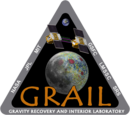
Back GRAIL (svemirske letjelice) BS Gravity Recovery and Interior Laboratory Catalan Gravity Recovery and Interior Laboratory Czech Gravity Recovery and Interior Laboratory German GRAIL Spanish GRAIL Finnish Gravity Recovery and Interior Laboratory French Gravity Recovery and Interior Laboratory Galician GRAIL HE GRAIL Hungarian
 Artist's interpretation of the GRAIL tandem spacecraft above the lunar surface. | |
| Operator | NASA / JPL[1][2] |
|---|---|
| COSPAR ID | 2011-046 (A, B) |
| SATCAT no. | 37801, 37802 |
| Website | moon |
| Mission duration | 1 year, 3 months, 7 days, 9 hours |
| Spacecraft properties | |
| Manufacturer | Massachusetts Institute of Technology, LMSS |
| Launch mass | 202.4 kg (each)[3] |
| Dry mass | 132.6 kg (292 lb) |
| Power | (Solar array / Li-ion battery) |
| Start of mission | |
| Launch date | September 10, 2011, 13:08:52.775 UTC |
| Rocket | Delta II 7920H-10 D-356 |
| Launch site | Cape Canaveral SLC-17B |
| Entered service | December 31, 2011 (Ebb) January 1, 2012 (Flow) |
| Orbital parameters | |
| Reference system | Selenocentric |
| Regime | Polar orbit[4] |
| Semi-major axis | 1,788.0 kilometres (1,111.0 mi) |
| Periselene altitude | 25 kilometres (16 mi) |
| Aposelene altitude | 86 kilometres (53 mi) |
| Period | 113 minutes |
| Lunar impactor | |
| Impact date | GRAIL A: December 17, 2012, 22:28:51 UTC |
| Impact site | 75°36′30″N 33°24′15″E / 75.6083°N 33.4043°E |
| Lunar impactor | |
| Impact date | GRAIL B: December 17, 2012, 22:29:21 UTC |
| Impact site | 75°39′01″N 33°09′51″E / 75.6504°N 33.1643°E |

| |

The Gravity Recovery and Interior Laboratory (GRAIL) was an American lunar science mission in NASA's Discovery Program which used high-quality gravitational field mapping of the Moon to determine its interior structure. The two small spacecraft GRAIL A (Ebb) and GRAIL B (Flow)[5][6] were launched on 10 September 2011 aboard a single launch vehicle: the most-powerful configuration of a Delta II, the 7920H-10.[1][7][8] GRAIL A separated from the rocket about nine minutes after launch, GRAIL B followed about eight minutes later. They arrived at their orbits around the Moon 25 hours apart.[9][10] The first probe entered orbit on 31 December 2011 and the second followed on 1 January 2012.[11] The two spacecraft impacted the Lunar surface on December 17, 2012.[12]
- ^ a b "Delta II Set to Launch NASA's GRAIL Mission". United Launch Alliance. 2011. Archived from the original on 1 September 2011. Retrieved 2 September 2011.
- ^ "The GRAIL Mission: A Fact Sheet". Sally Ride Science. 2010. Archived from the original on 2010-04-28. Retrieved 2010-04-15.
- ^ "GRAIL" (PDF). NASA. Retrieved November 30, 2022.
- ^ Cite error: The named reference
AboutGRAILwas invoked but never defined (see the help page). - ^ Schontzler, Gail (18 January 2012). "Bozeman class wins contest to name satellites orbiting moon". Bozeman Daily Chronicle. Retrieved 2018-12-18.
- ^ Agle, DC. "Montana Students Submit Winning Names for NASA Lunar Spacecraft". NASA JPL. Archived from the original on 2021-02-25. Retrieved 2012-01-17.
- ^ Delta II: The Industry Workhorse (PDF) (Report). United Launch Alliance. 2010. Archived from the original (PDF) on 30 September 2011. Retrieved 2 August 2011.
- ^ Grey Hautaluoma (10 December 2007). "New NASA Mission to Reveal Moon's Internal Structure and Evolution". NASA. Archived from the original on 24 February 2021. Retrieved 31 August 2011.
- ^ Moon-bound twin GRAIL spacecraft launch success
- ^ Spaceflight101 Archived 2015-02-11 at the Wayback Machine
- ^ "First of NASA's GRAIL Spacecraft Enters Moon Orbit". NASA. Archived from the original on 25 February 2021. Retrieved 1 January 2012.
- ^ GRAIL Twins crash into the Moon to complete highly successful Mission Archived 2015-02-11 at the Wayback Machine
© MMXXIII Rich X Search. We shall prevail. All rights reserved. Rich X Search